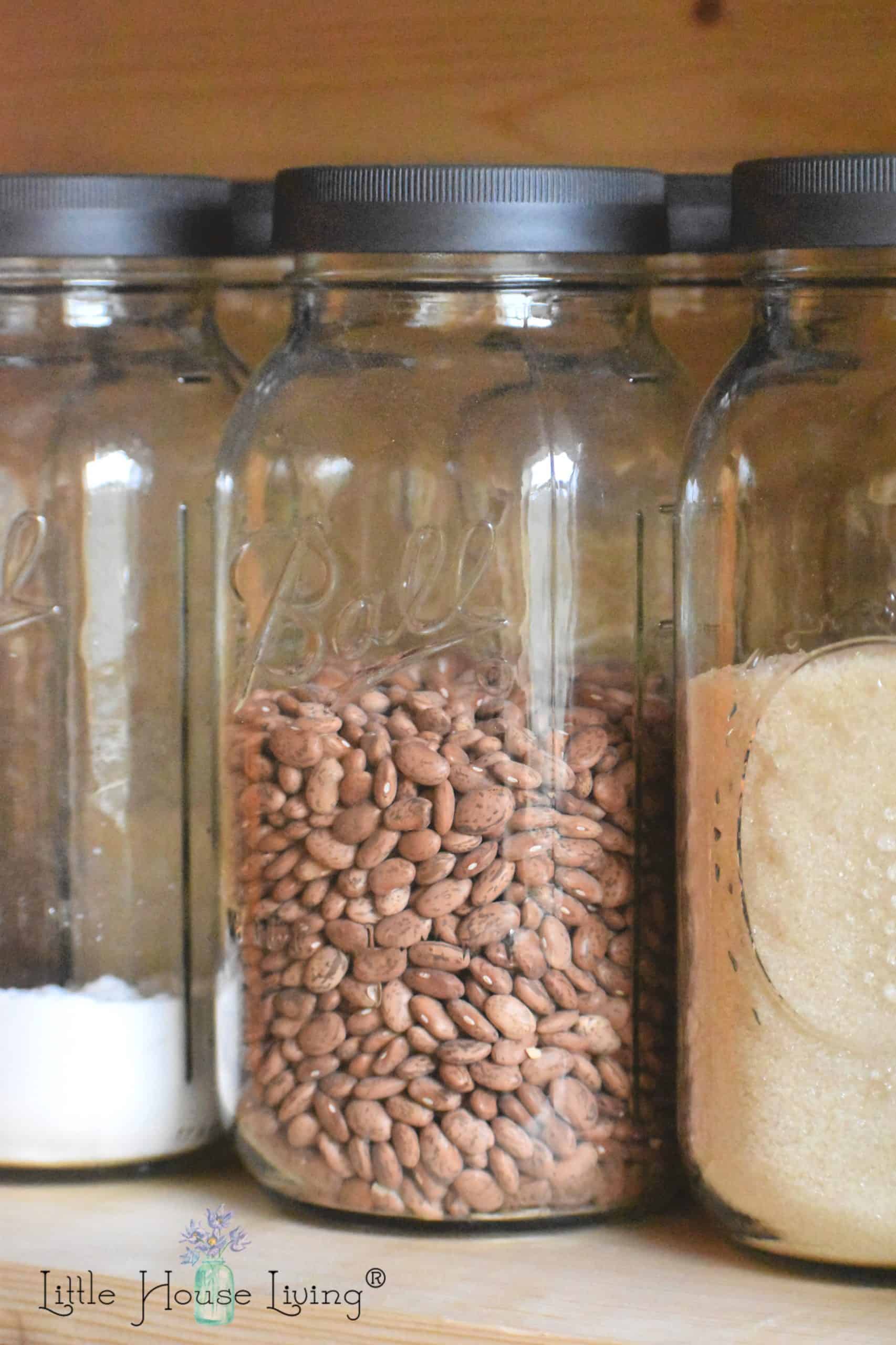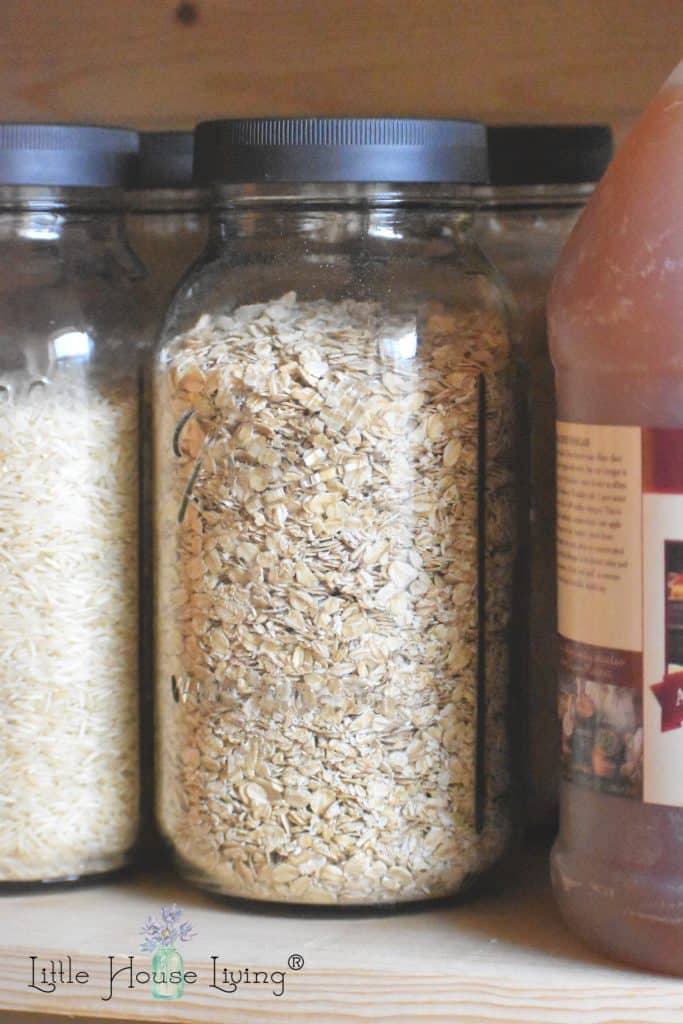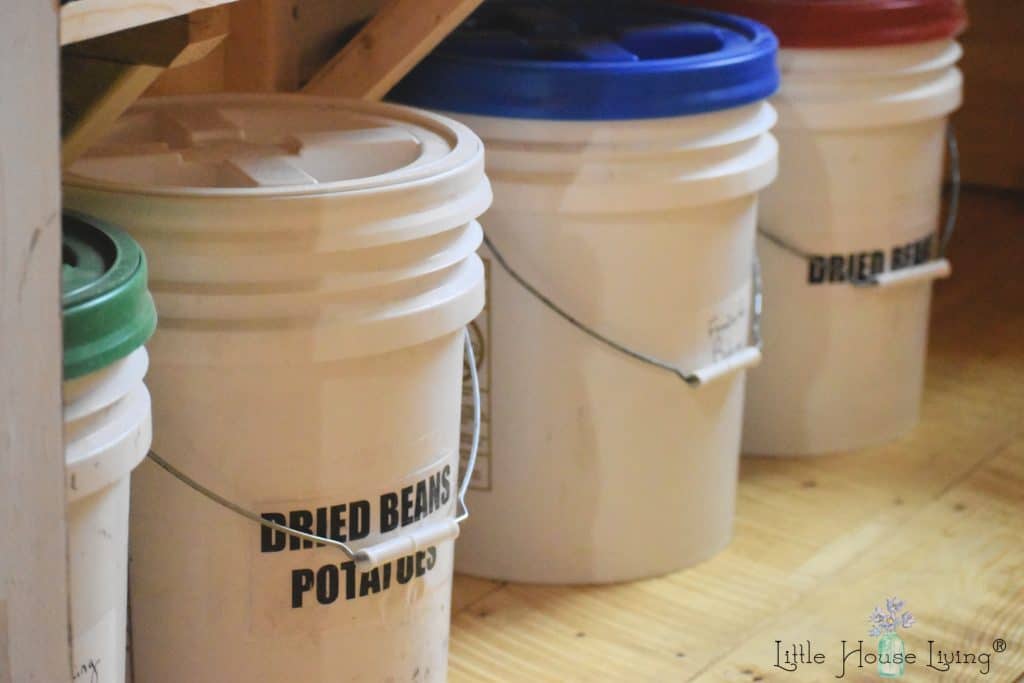Staples That Should Be in Every Frugal Pantry
This post may contain affiliate links. Read our disclosure policy here.
Are you unsure of what you should be stocking in your pantry? Today I’m sharing the basics of every good frugal pantry!
Staples That Should Be in Every Frugal Pantry
So many times have I been asked, “What are the most important things to have in a well-stocked pantry?” And yet, I’ve failed you, my readers, in getting this blog post written!
Ah well, better late than never right?
As I’ve been working even harder to have a very well-stocked pantry at our new home since we are so far from any grocery stores, I’ve been thinking a lot about this lately. What exactly are the best things to keep in your pantry at all times?
While this list will vary based on your family’s needs and preferences, I think it’s a good basis to start off your pantry with. You can use this list to learn how to fill your pantry shelves if you are just starting a brand new pantry or if you are looking to get back to the basics with a pantry that is over-run with too much.
–Click here to learn how to build a stockpile with $5 per week.
Beans
Beans are one of the best staples to have in any frugal pantry. They are inexpensive and they can be stretched a long ways. Plus they are a great non-meat source of protein. Our favorite beans to have in our pantry at all times are garbanzo beans, black beans, and pinto beans. On occasion, I will also stock some kind of red bean, but we use it less often than the first 3 I mentioned.
Flour
All frugal pantries need to be well-stocked with flour so you can make your own baked goods! We always have a 5-gallon bucket of gluten-free flour blend (See my recipe here), but if you do lots of baking (and aren’t gluten free) you might want to have even more on hand. You may also want to have different types of flour such as whole wheat if that is something you use often.
–Learn how to store your food storage and keep the pests out.
Baking Soda/Powder
These ingredients both belong in any frugal pantry because they are a staple in baking of course. I always keep extra baking soda in my pantry (I buy in bulk, the 13lb bag) because we use it in so many cleaning applications as well such as this Miracle Microwave Cleaner.
Baking Powder also gets a lot of use in my home as well since we use it to make all kinds of Quick Breads and Muffins.
Salt
Of course, salt is probably the most important ingredient in a frugal pantry! We all know that some frugal meals tend to taste a little on the boring side, and salt can help remedy that problem. We use pink salt and I buy it in bulk, never in the small containers which are so much more costly.
Oats
Oats are something that I think should belong in every frugal pantry because they are so versatile. You can use them in desserts, you can use them for breakfast, you can even grind them up and use them for flour. Plus they are a great inexpensive item to buy from the store or to buy in bulk!
Some of our favorite oat recipes are:
- Instant Oatmeal Packets
- Oatmeal Lace Cookies
- Oatmeal Bar Cookie Recipe
- Homemade Oatmeal Raisin Granola Bars Recipe
- No Nut Oatmeal Bites Recipe for Kids (Plus Free Printable!)
Home Canned Fruits and Vegetables
I don’t think that most of us live on bread alone, so having a good supply of home-canned fruits and vegetables in your pantry is always a smart idea. You can learn to start canning with these basic recipes. Water bath canning can be done in any large stockpot and since most fruits can be water bath canned, there really is no excuse not to give it a try. I promise that it’s easier than what you are thinking!
Home Canned Vegetables are a little more difficult since most need to be pressure canned to be shelf-stable, however, you could get around this by storing up vegetables in your freezer or dehydrating them if you want something shelf-stable.
Home Canned Jams
Jams are another easy thing to can since almost all are done in a water bath. I felt that they belonged on the frugal pantry list, even though they aren’t always the most frugal thing to use or make because they can really add a lot to a meal.
Jam or jelly can be added to meat to give it a new flavor, it can be used in a sandwich for a simple lunch, it can be added to meals like French toast to dress it up…there are so many ways to use this simple food item!
–Here are Summer Jelly Recipes you need to try!
Onions/Garlic
While I know not everyone has a good root cellar to store fresh foods, just about anyone can store onions and garlic on a cool pantry shelf. Onions and garlic are inexpensive to buy but they add SO much to a good frugal meal.
Onions and garlic are easy to store as well. Just make sure to keep an eye on them and remove any from your pantry that are starting to have green growth from the stem.
Potatoes
Potatoes are one other “fresh” item that I had to add to the frugal pantry list. They are also easy to store (just watch them to make sure they don’t grow mold or eyes).
Potatoes are always a great frugal staple because they can be the basis for so many meatless meals.
Grains
What kind of grains go in your pantry will be up to your family’s eating habits. As a mostly gluten free household, we keep rice on hand at all times and sometimes we also stock quinoa. I rarely keep other gluten free grains (millet, amaranth, etc) because I’ve found them to be too expensive to keep in our frugal pantry. We mostly stick with rice because it’s cheap and it’s filling.
Dried Herbs and Spices
One of my favorite things to keep in my frugal pantry is an array of dried herbs and spices. In another post, I’ve shared just How Herbs and Spices Can Save You Money so I won’t get into detail on that here. The main thing to know is that you should be keeping your favorite dried herbs and spices in your frugal pantry at all times.
Another thing to remember is to buy those herbs and spices in bulk. My favorite places to get them are Azure Standard and Starwest Botanicals.
Oils
Cooking and baking would be quite difficult if it weren’t for oils and that’s why they made it on to y frugal pantry list. Like grains, most people use different kinds based on how you cook and your family’s preferences.
We usually have olive oil and coconut oil on hand at all times. I buy both in bulk from Azure Standard.
Sugars
Finally, I had to add sugar onto my frugal pantry must-have list. I know that not everyone eats sugar or the same kinds of sugar, but since it’s used in so many baking recipes and other staple recipes, it has a place on this list.
We always keep honey (local), maple syrup, and a small amount of cane sugar (used for Kombucha) on hand at all times.
Apple Cider Vinegar
I can’t even begin to tell you all the things that I use this for! I usually don’t use white vinegar in recipes so I don’t always have that on hand. But I do always keep ACV on hand. I use it in my canning as well.
There are many other items that are in my pantry and that I’m sure are in your pantry, but this is a good list of basics that you can start from and use to grow your own frugal pantry and stockpile.
Most of the items on this list are inexpensive, can be found in any grocery store or in most bulk foods stores, and are very easy to store.
I hope this gives you some inspiration as you work through building your own frugal pantry!
Looking for the storage supplies you can see in my pantry pictures? Here’s where I get my:
- Half Gallon Ball Jars (And I use these Measuring Spoons to get things out of them)
- Grey Plastic Lids
- Food Grade Buckets
- Gamma Lids
Want to know where I buy my supplies? Check out my Frugal Resources page!
What other items are in your frugal pantry?









Thank you for the list. I will share this page with the Facebook Page I am a member of as an aid.
Thanks for the share!
This is a helpful starting point. Thank you!
I’m glad you found this helpful! 🙂
Thank you. This was a great article.
You’re welcome!
These are great suggestions. I buy beans, oats, rice and wheat in #10 cans. They have a very long shelf-life. The flour comes in bags and those were put in the freezer for a week (after being poured into a air-tight container) to kill any bugs/larvae/eggs, so gross, and then transferred it into 1/2 gallon mason jars to dry pack. And it sure has come in handy during this quarantine!
I am starting to replenish my pantry after so many weeks of not shopping. This is a good list to start with. Unfortunately, I am unable to can (no equipment and live in an apartment) but I will be restocking my fruits and veggies in cans and jars from the stores. I do dehydrate some of my own, however. In fact I was given potatoes recently and knew they would likely go bad before I could ever use them so I dehydrated mashed, grated (hash browns) and slices for later use.
Any way that works for you to restock is good! I love that you did dehydrated hashbrowns. I’m going to have to try that sometime!
Leanne, I too live in apartment, and I haven’t any canning equipment. The reason I don’t do canning is arthritis in my hands. I can dehydrate foods, however; I have a dehydrator. I like your idea of dehydrating potatoes. J love potatoes, so I’ll try it. Thank you for the idea!
This is a great list. I live in the country and have had a pantry since moving here. I have all the items you suggested but I thought of a couple things I keep. We have quart size and gallon size freezer bags and also just storage bags in same size. Freezer bags are spendy but storage bags are a little bit cheaper so we use Freezer if going into freezer. Also condiments mustard, I like the little lemons in plastic look like lemon container.
I agree on the freezer bags…I seem to use them all the time for things!
I love your list. It is what I keep on hand, too. For grains I usually have white and brown flours and rice, and when I can find it, whole barley, which I use like rice but which has (in my opinion) better nutrition (fiber, protein, better glycemic index than rice) and can be used like rice, or in soups, in bread, or as a breakfast grain, and it is fairly cheap. I also keep on hand some cornmeal. I don’t keep quinoa anymore as it is a bit pricey for me and seems to go stale quickly, but instead I try to always have on hand ground flax (an egg back up but also great in bread or smoothies), and nuts (I keep them in the fridge so they stay fresh longer), dried fruit (sometimes i dehydrate it myself), dried peas (cheap and a good protein source), and I’m starting to use lentils as a meat substitute as well as an ingredient in its own right… just tried a faux roast (and gravy) with them and it was yummy!
I was wondering what you keep on hand of other things… like lemons or lemon juice, eggs, fresh, powdered or canned milk, oils… things like that? What are your essentials?
Hmm, that’s a good question. I think the answer is longer than I could type out in a comment box so I will have to add it to my blog post to-do list!
Keeping the little critters out of dry grains is a problem for me. How do you keep the little buggers at bay? I read the other post and the freezer is a good idea, too. I will try that too.
Thanks for all you do, Regina
Here’s a post all about that! How to Keep Your Food Storage Protected From Pests
Regina, bay leaves work wonders at keeping crawlies out of grain. I use them myself. They don’t cost all that much, so you can scatter them about in your pantry and keep two or three in every container.
I would add lentils and split peas, nut butters, and along with potatoes cabbage, celery and carrots… these are Staples in my kitchen as well as those you had in your list… of course we could go on with other items such as canned tomatoes but then maybe you will do another article covering the basics…
Living in West Central Florida we tent to stay stocked up and prepared because of hurricane season. You just get in the habit of rotating your supplies through out the year. I learned some new things from your blog, thank you!
I’m in the same situation as Leanne, in that I live in an apartment & haven’t a canning setup. My kitchen is entirely too small to do that sort of thing. It’s what is called a “galley kitchen”—-as in one step between stove and sink. So I too buy foods in cans and jars. I was given a brand-new food dehydrator by a woman in our congregation, so I’m going to try my hand at it. Thank you for your recommendations! I’m always on the lookout for such things.
We had the same idea!
Excellent list. I would add fine grain cornmeal for making polenta as well as a bigger grain cornmeal for making cornbread, corn muffins, and even with bread and Pizza crust. Someone asked about lemons, I make preserves lemons from fresh lemons…all you need is a jar, unwaxed lemons, sea salt and a knife. No special equipment. They are used in Moroccan cooking, Middle Eastern cooking, and some Mediterranean cooking. It is the skin that is used and it adds such impact to a meal. I make Moroccan Chicken for hubby and Moroccan cauliflower for me. I add to a variety of other foods too. I also added olives to my pantry list, marinated artichokes that I tend to make myself as I grow them, su dried or oven dried tomatoes in olive oil, same for roasted peppers. Chia seeds, flax seeds, corn starch, dried fruits sick as raisins, cranberries, apple rings, mangoes and banana chips. I buy when on sale if I am unable to grow them and dehydrate and store them. Dehydrated mushrooms are another essential for me, great for soups, ground into a powder it makes a great addition to soups, stews, gravies, etc. I dehydrate onions, garlic, leeks, celery, and carrots as well. I save all the little silica gel packs from new purses, shoes, etc. And add the. To the dehydrated things to keep moisture at bay. Coconut milk is another thing I buy and keep on hand for curries but, I also use the thick cream in the can for making non dairy whipped cream. I keep tins of chick peas too as well as dried simply because the liquid the chickpeas are in makes a great eggless meringue (it is known as Aquafaba) among other recipes for vegans. Powdered milk for Hubby as well as instant coffee for emergencies. Black salt for me which has an eggy flavour and makes scrambled tofu taste like scrambled eggs. I do this for breakfast burritos as well as for faux scrambled eggs. I have also added chocolate chips, for making fudge, cookies, etc. Chestnuts, dehydrated, whole vacuum packed, and tons of creamed chestnuts (unsweetened as I can sweeten it if doing a dessert). It is great added to mushrooms and seasonings for vegan meals. I have also stocked up on tofu that does not require refrigeration u Til opened and the same for plant milk. But, I really stock up on oats as I make my own oat milk and use the left over oats to top homemade bread, rolls, and even breakfast bars, once I dry them out. I bought a large bottle of brandy and have been buying vanilla beans when they are on sale as they are due to expire and chop them up, put in a jar and top with brandy or vodka to make my own vanilla. It must be kept in a dark place though. I have also been buying up vodka when on sale as well as everclear when I can find it, for making herbal tinctures for certain medicines. While technically not a pantry food item, I also stock at the same time and store in my pantry, toothpaste tablets, mouthwash tablets, and Castile soap as the soap can be grated, added to water and used as a cleaner for everything, body, shampoo, dish soap, laundry soap, floor cleaner, wood cleaner, and so on. I buy the scent free and then add my own scents to them. I also added lentils of all colours, split peas of all colours (if you have an international area in the shop they can often be sold in the Indian section and sold as dhal). And while I am an American, I now live in Scotland, so have become a tea drinker, so tea bags were added to my pantry list. I have also bought some 100% organic cotton and made a bunch of reusable teabags to make my own herbal teas as well as for grinding coffee beans really fine and adding to the teabag to make a single cup of coffee. I store the beans in the freezer once opened and buy when on sale.
Shelley, what is black salt, and where can I find it? I’d like to taste it. I’ll try anything once, which is how I found out I love oysters! If I still don’t like the taste of something after I’ve tried it at least four times, I won’t eat it again. But I never heard of black salt till I read your post? Can I make it myself?
hi Shelley,
It’s almost like we are twins. I was reading your post and we do many of the same things, such as making vanilla, using barley and barley flour, egg substitutes of all sorts, AND… my husband is Scottish and we are currently in America, so that’s the flip side, but I do a lot of Scottish cooking and we go back for extended stays. I’m always trying to learn more Scottish ways in cooking, gardening, and other things to add to my repertoire.
I have not tried the lemon trick, though! I am excited about doing that. Thank you for mentioning it!
is there a list of staples that can be printed out. thank you
I don’t have one right now. Sorry! You can always print this blog post though by clicking the “Print Friendly” green button at the bottom of the post.
Do we have to can the flour, rice, etc., and if so how do we do that?
I don’t do any “dry canning”. All flour and other dry goods to be used soon are in glass jars. Any others that will be stored for several months are storing in 5 gallon buckets with Gamma lids for an airtight seal.